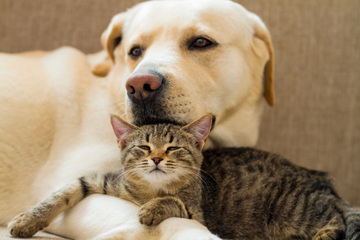Pets and Skin Cancer.
Can Animals Get Skin Cancer?
Skin cancer in animals, particularly in pets like dogs and cats, is a significant health concern that mirrors the human experience with this disease. It ranges from benign conditions that may need little to no intervention, to malignant tumours requiring comprehensive and often aggressive treatment. Understanding the types of skin cancers that commonly affect pets, their signs, and the importance of early detection can empower you to take proactive steps in managing your animals' health.
Common Types of Skin Cancer in Pets
- Squamous Cell Carcinoma (SCC): SCC is a common type of skin cancer in pets, particularly in areas with little to no fur coverage, making them more exposed to the sun. In cats, it can frequently be found on the ears, eyelids, and nose, while in dogs, it may also appear on the abdomen and limbs. Early stages might resemble sores that do not heal, progressing to more pronounced tumours.
- Melanoma: While often benign in humans, melanoma can be more aggressive in dogs and is typically found in the mouth or on the digits. It appears as a darkly pigmented mass, but not all melanomas are pigmented. In cats, melanoma is less common but can be very aggressive.
- Mast Cell Tumours: These are the most common skin tumours in dogs and can range from very benign to highly malignant. They can appear anywhere on the body and may vary greatly in appearance, making them harder to identify without professional diagnosis.
Signs of Skin Cancer in Pets
The signs of skin cancer in pets can vary widely depending on the type of cancer and its location.
However, some common indicators include:
- New lumps or growths on the skin that change in size or appearance.
- Sores that do not heal.
- Changes in the colour or texture of the skin or existing moles.
- Swelling in areas around the body that persists or grows.
- Unexplained bleeding or discharge from any part of the body.
Importance of Early Detection
Early detection of skin cancer in pets can significantly improve the outcome and effectiveness of treatment. Regularly checking your pet's skin and coat for any abnormalities and seeking veterinary attention for any concerns is crucial. Early stages of skin cancer can often be managed more effectively and with less invasive treatments than those detected at a more advanced stage.
Prevention and Treatment
While not all forms of skin cancer can be prevented, especially those with a strong genetic component, minimising your pet's exposure to known risk factors, such as excessive sun exposure, can help reduce the risk. For pets with light skin or thin fur, protective clothing or pet-safe sunscreen can offer additional protection.
Treatment options vary widely based on the type of cancer, its stage, and location, and may include surgery, chemotherapy, radiation, or a combination of these. The treatment plan is tailored to each individual pet's needs to ensure the best possible quality of life.
Skin cancer in pets, like in humans, presents a significant health challenge that requires awareness and proactive management. Understanding the types of skin cancer that can affect dogs and cats, recognizing the signs, and the critical importance of early detection can help pet owners safeguard their companions' health. Regular veterinary check-ups and prompt attention to any skin changes are key in managing this risk and ensuring pets lead healthy, happy lives.
Squamous Cell Carcinoma in Pets
SCC is a type of skin cancer that originates in the squamous cells, which compose most of the skin's upper layers. In pets, it can develop in areas that are sparsely haired and frequently exposed to the sun, such as the ears, nose, and eyelids, particularly in animals with light-coloured or thin coats. However, SCC can also appear in the mouth or other parts of the body. Signs of SCC may include non-healing sores or ulcers, raised growths with a central depression, or crusty patches on the skin.
Melanoma in Pets
Melanoma is another common form of skin cancer in pets, particularly in dogs. It arises from pigment-producing cells called melanocytes, which can lead to the formation of dark-coloured or pigmented tumors. While melanomas on the skin are often benign, those that develop in areas like the mouth or toes can be particularly aggressive and prone to spreading. Symptoms of melanoma can vary depending on the tumour's location but may include visible swelling, difficulty eating (if in the mouth), or a noticeable lump.
Monitoring and Early Detection
Pet owners play a crucial role in the early detection of skin cancer in their animals. Regularly checking your pet's skin for any lumps, bumps, or changes can help catch cancer early, when it's most treatable. Look for new growths, changes in existing moles or spots, sores that don't heal, or any area that seems to cause your pet discomfort. Early detection significantly improves the prognosis for pets with skin cancer, as many forms of the disease are treatable if caught early.
Treatment Options
Treatment for skin cancer in pets depends on the type of cancer, its location, and how advanced it is.
Options may include:
- Surgery: Often the first line of treatment to remove tumors.
- Radiation Therapy: Used for tumors that cannot be fully removed surgically or for those in locations where surgery is challenging.
- Chemotherapy: May be recommended for cancers that have spread or are at high risk of spreading.
- Immunotherapy: Particularly for melanoma, vaccines can sometimes help to stimulate the immune system to fight the cancer.
Preventive Measures
While not all forms of skin cancer can be prevented, certain measures can reduce the risk, such as limiting your pet's exposure to sunlight, especially during peak sun hours, and considering protective clothing for pets with thin or light-coloured coats. Regular veterinary check-ups are essential for maintaining your pet's overall health and for early detection of potential issues, including skin cancer.
Skin cancer is a concern for pets as well as humans, with squamous cell carcinoma and melanoma being among the most common types affecting animals. Pet owners should monitor their animals' skin for any changes and seek veterinary care for any concerns. Early detection and treatment are key to successfully managing skin cancer in pets, highlighting the importance of regular health checks and preventive care.

How to Protect Your Animal from Skin Cancer
Protecting pets from skin cancer involves a combination of practical steps to minimise UV exposure and maintain overall skin health. Given that certain animals, especially those with short hair, light-coloured or white fur, or with minimal pigmentation, are more prone to the damaging effects of the sun, these protective measures are crucial.
Here's how to safeguard pets from the risk of skin cancer:
Limit Sun Exposure
- Shade: Ensure pets have access to shaded areas when outdoors, especially during peak sun hours (10 AM to 4 PM), when UV rays are strongest.
- Sun Protection Clothing: Pet-specific sun protection clothing offers a physical barrier against UV rays. These garments are especially beneficial for pets with thin or light-colored coats.
- Pet-safe Sunscreen: Sunscreens formulated specifically for pets can protect exposed areas such as the nose, ear tips, and any area where the coat is thin. It's vital to use products intended for pets, as some ingredients in human sunscreens can be toxic to animals.
Minimise Outdoor Time During Peak UV Hours
- Indoor Activities: During times of the day when the sun's rays are most intense, consider indoor activities to keep your pets entertained and safe from UV exposure.
- Early Morning or Late Afternoon Walks: Adjust walk times to early morning or late afternoon/evening when the sun is less intense.
Avoid Shaving
- Natural Protection: Pets' coats offer natural protection against the sun. While trimming longer hair can help keep pets cool during hot weather, avoid shaving down to the skin, particularly for pets prone to skin cancer.
- Grooming: Regular grooming can help manage pets' coats without the need for shaving, ensuring they maintain some level of protection against UV rays.
Regular Skin Checks
- Monthly Inspections: Conduct thorough skin checks on your pets at least once a month. Look for new growths, changes in existing growths, sores that don't heal, or any areas that seem painful or sensitive to touch.
- Veterinary Examinations: Annual veterinary check-ups should include skin examinations. For breeds at higher risk of skin cancer, more frequent checks may be advisable.
Proper Nutrition
- Balanced Diet: A balanced diet rich in antioxidants can support skin health and the immune system. Some pet foods are formulated to support skin health specifically.
- Supplements: Supplements containing omega-3 fatty acids, vitamins E and C, and other antioxidants may provide additional support for skin health, though it's important to consult with a veterinarian before adding supplements to your pet's diet.
Extra Protection for High-Risk Breeds
- Breed-Specific Care: Recognise if your pet's breed is at higher risk for skin cancer and take extra precautions. This may mean more stringent sun protection measures and more frequent skin checks.
- Veterinary Advice: Consult with a veterinarian about specific risks associated with your pet's breed and the best preventive measures to take.
Implementing these protective measures can significantly reduce the risk of skin cancer in pets. It's a combination of vigilance, preventive care, and adopting habits that prioritise your pet's skin health, particularly for those breeds more susceptible to UV damage
What is Melanoma?
Melanoma is a type of skin cancer that originates from the pigment-producing cells (melanocytes) in the skin. It is known to be the most dangerous form of skin cancer due to its potential to spread to other parts of the body if not detected and treated early. Symptoms include the appearance of a new or changing mole, or a sore that does not heal. Early detection and treatment are crucial in increasing the chances of a successful outcome.

What is Squamous Cell Carcinoma?
Squamous Cell Carcinoma (SCC) represents a significant concern in veterinary medicine, mirroring its status as a health issue in humans due to its aggressive nature and potential for metastasis.
In pets, particularly dogs and cats, SCC arises from squamous cells, which compose the superficial layer of the epidermis. While sun exposure is a well-recognised risk factor, especially in areas of the skin with sparse hair or light pigmentation, SCC can also develop in less exposed areas, underscoring the complexity of its etiology.
Etiology and Risk Factors
- Sun Exposure: Prolonged exposure to ultraviolet (UV) rays can damage the DNA of squamous cells, particularly in areas with little to no fur coverage, such as the ears, nose, and abdomen. Pets with light-coloured or thin coats are at an increased risk.
- Tobacco Smoke: Pets exposed to tobacco smoke may have an increased risk of developing oral SCC, highlighting the environmental component of this cancer.
- Genetic Factors: Certain breeds may have a genetic predisposition to SCC, suggesting a hereditary component that influences susceptibility.
- Papillomavirus: In some cases, especially those involving the skin, viral infections such as papillomavirus have been linked to the development of SCC in animals.
Clinical Presentation
SCC can manifest differently depending on its location:
- Skin: Appears as firm, raised, and often ulcerated growths that can be mistaken for wounds or other benign skin conditions.
- Oral Cavity: May present as a mass in the mouth, leading to symptoms such as difficulty eating, bad breath, or drooling. Oral SCC is particularly aggressive and can rapidly invade surrounding tissues.
- Nail Bed: SCC can affect the toes, leading to swelling, lameness, or loss of a toenail.
Diagnosis
Diagnosis of SCC involves a thorough physical examination followed by diagnostic tests such as:
- Biopsy: A sample of the tumor is examined microscopically to confirm the diagnosis of SCC.
- Imaging: X-rays, ultrasounds, or CT scans may be used to assess the extent of the disease, particularly for internal tumors or to check for metastasis.
Treatment
Treatment options vary based on the tumor's location, size, and whether the cancer has spread:
- Surgery: Removal of the tumour is often the first line of treatment, aiming to excise the cancer fully.
- Radiation Therapy: Used for tumours that are difficult to remove surgically or to treat areas where surgery isn't possible, such as the mouth or throat.
- Chemotherapy: May be considered for advanced cases or when the cancer has metastasized.
- Cryosurgery: For smaller skin lesions, freezing the tumour with liquid nitrogen can be an effective treatment.
Prognosis
The prognosis for pets with SCC varies. Skin SCCs, if detected early and completely removed, often have a good prognosis. Oral SCC, due to its aggressive nature and tendency to be diagnosed at a more advanced stage, typically has a poorer prognosis. The success of treatment depends on early detection, the location of the tumour, and the cancer's stage at diagnosis.
Prevention
Preventive measures include minimising sun exposure for pets at high risk, reducing exposure to known carcinogens like tobacco smoke, and regular veterinary check-ups. For pets with light-colored fur or sparse hair in sun-exposed areas, the use of pet-safe sunscreen or protective clothing can also help reduce the risk.
In summary, SCC in pets is a serious condition that underscores the importance of early detection and prompt treatment. By understanding the risk factors and maintaining regular veterinary care, pet owners can play a crucial role in identifying early signs of SCC and improving their pets' quality of life and prognosis.
| Powered by Kaptol Media


